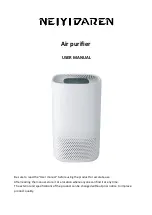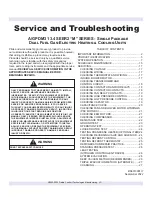
20
S4359128
Loose wiring may cause the
terminal to overheat or result
in unit malfunction. A fire
hazard may also exist.
Therefore, ensure that all
wiring is tightly connected.
When connecting each power wire to the correspond-
ing terminal, follow the instructions on “How to connect
wiring to the terminal” and fasten the wire securely with
the fixing screw of the terminal plate.
6-5. How to Connect Wiring to the Terminal
■
For solid core wiring (or F-cable)
(1)
Cut the wire end with a wire cutter or wire-cutting
pliers, then strip the insulation to expose the solid
wire about 1 in.. (Fig. 6-3)
(2)
Using a screwdriver, remove the terminal
screw(s) on the terminal plate.
(3)
Using the pliers, bend the solid wire to form a
loop suitable for the terminal screw.
(4)
Shape the wire loop properly, position it on the
terminal plate and fix it securely with the terminal
screw using a screwdriver.
■
For stranded wiring
(1)
Cut the wire end with a wire cutter or wire-cutting
pliers, then strip the insulation to expose the
stranded wiring about 3/8 in.. (Fig. 6-4)
(2)
Using a Pillips head screwdriver, remove the
terminal screw(s) on the terminal plate.
(3)
Using a ring connector fastener or pliers, securely
clamp each stripped wire end with a ring pressure
terminal. (Fig. 6-4)
(4)
Place the ring pressure terminal, and replace and
tighten the removed terminal screw using a
screwdriver. (Fig. 6-5)
1004_M_I
Strip 1 in.
Solid wire
Loop
Insulation
Fig. 6-3
Fig. 6-4
Fig. 6-5
Stranded wire
Ring
pressure
terminal
Strip 3/8 in.
1106_M_I
Wire
Special
washer
Screw
Ring pressure
terminal
Terminal plate
Screw and
Special washer
Ring
connector
Wire
1308_M_I








































